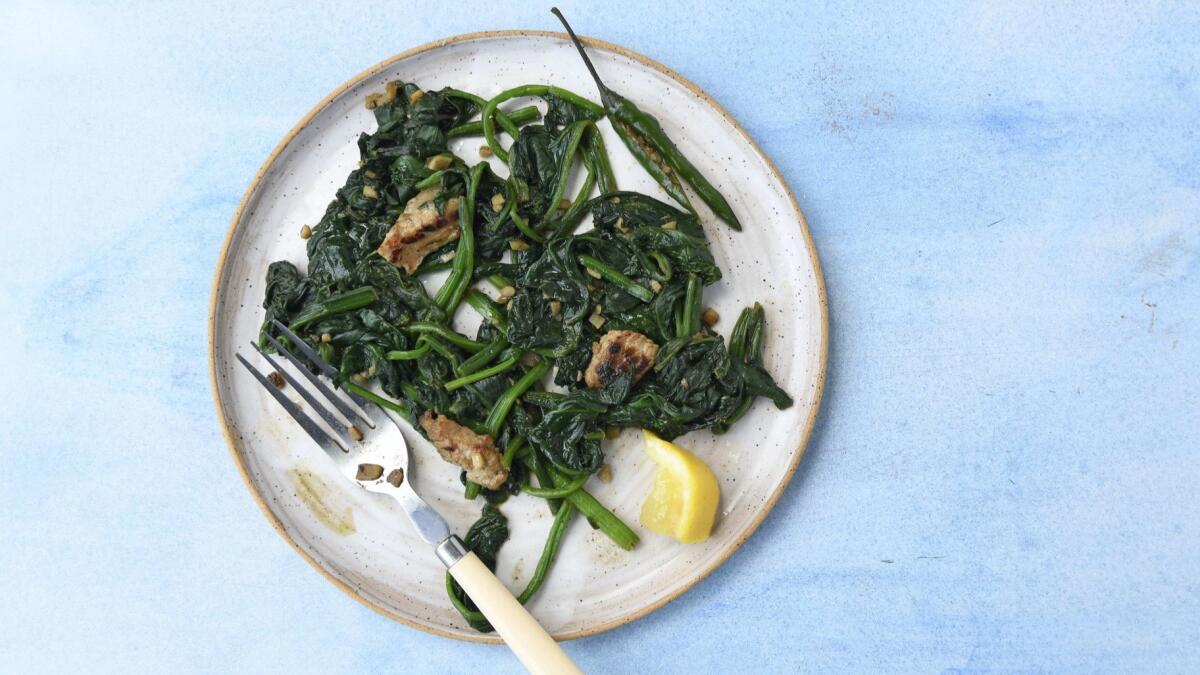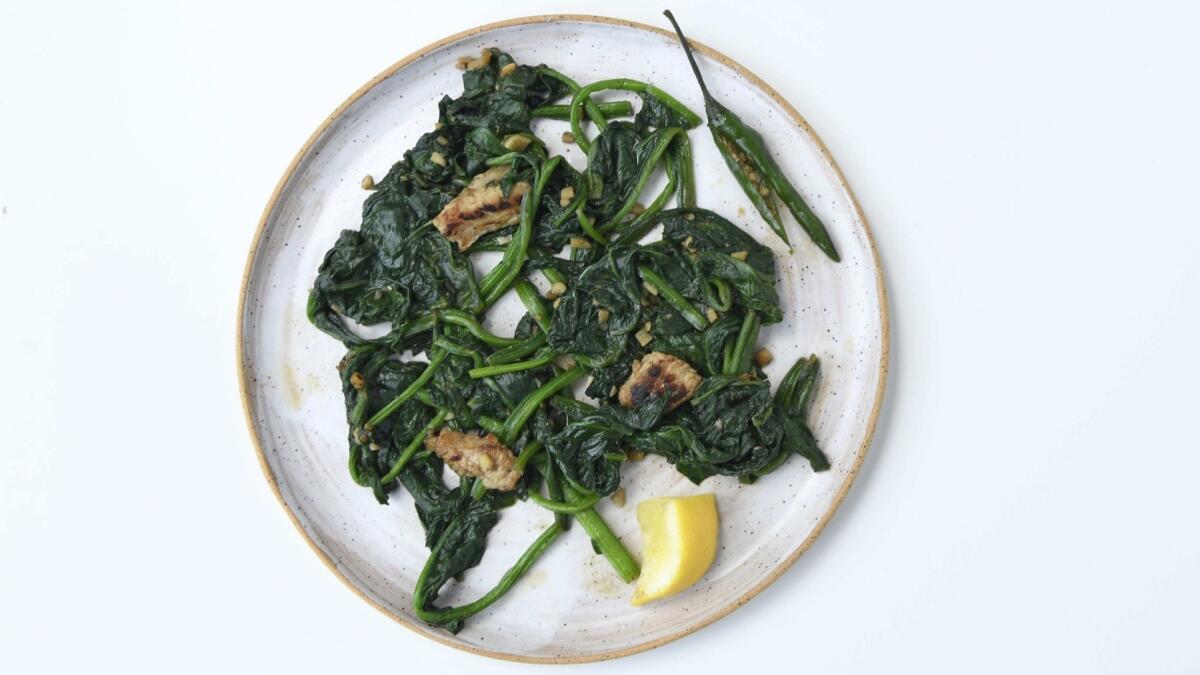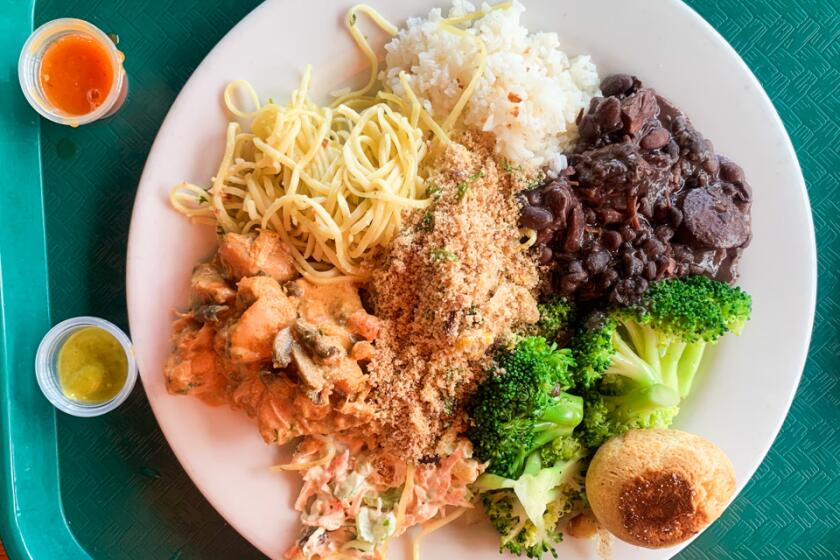Off the shelf: The powerfully funky umami of Vietnamese shrimp paste

Fish sauce has crossed over from Vietnamese cuisine to use in all kinds of home and restaurant cooking, but it’s hardly the only fermented sea beast potion that Viet cooks love. When you’re ready to take the next step into Southeast Asian umami, get yourself a jar of fermented shrimp paste, or mam tom.
My favorite, the Koon Chun brand, is a finely ground paste that’s colored sort of gray-brown-purple; the smell straight out of the jar is akin to the really dank smell of a French Quarter dumpster during Mardi Gras. I’m not alone in this: In a piece for Taste on the Thai variety of shrimp paste, writer Mari Uyehara compared it with “a bag of trash on a hot August night.” These are qualities you are looking for! Its pushier character means that it’s a sauce that’s best to take in small doses. For that reason, you’ll most often find shrimp paste in a supporting role, cheering on the big, meaty flavors of bun bo Hue, or stir fry of chopped pork, lemongrass and chiles.
Unlike its solidly dehydrated counterparts in Thailand and the Philippines, mam tom has more of a toothpaste texture. All the peoples of Southeast Asia have their own version — this North Vietnamese version is more liquidy and fine than the rest, though the processes are generally the same. Often, the end results depend on whatever the typical local shrimp might be, because they vary in size and flavor.
The beauty of fermented shrimp paste is in how the flavor of shrimp has been, like a glob of molten steel, folded over and over onto itself to create a potent end product. In coastal Vietnam, the process of making this paste utilizes this same method of repetitive action: a mass of shrimp are dried, ground up, pickled, then dried again, each step concentrating and sharpening the flavor. Northern Vietnamese favor a more finely ground paste made from big shrimps, while Central Vietnamese make a rougher, redder paste from the tiny, krill-like shrimp found there.

For years, Vietnamese American cookbook author and expert Andrea Nguyen has maintained that Americans need to wise up to the wonders of fermented shrimp paste. For consistency, Nguyen favors the Lee Kum Kee and Koon Chun brands, both of which call the condiment “finely ground shrimp sauce.” From an early age, Nguyen knew that mastering fermented shrimp paste had everything to do with making it work in tandem with other strong flavors.
“I grew up with a mom who was like, if we had mam tom for anything, she would say in Vietnamese ... ‘Cook it, cook it!’” Nguyen told me. “The way she would ‘cook it’ would be to have something acidic, so lime juice.” At her house, the resulting dipping sauce, a concoction of the paste, lime juice, sugar, water and fish sauce, was often paired with the fresh and light flavors of cha ca La Vong, or turmeric-marinated fish.
But you don’t always have to stick with limes: Nguyen’s spicy-sweet-acidic recipe for umami ketchup utilizes the same principles but with tomato and rice vinegar. If you want to play around with dipping sauce recipes, you can do like a true Vietnamese grandma does and add crushed canned pineapple, which pairs really well with grilled beef. You just need something tart to slice through the thick fog of fermented shrimp flavor. “It’s that sense of gravitas,” Nguyen said. “Shrimp paste lends that little bit of oomph to a dish.”
Made too much dipping sauce and not sure what to do with it? Diep Tran, owner of the recently closed Good Girl Dinette in Highland Park, loves to pair fermented shrimp paste with rau muong, or water spinach. “That’s the stereotype people in Vietnam have about Bac Ky (Northern Vietnamese), right? We love rau muong and mam tom. They’re so good together.” An easy way to whip up that dish is to blanch the greens and toss them with the aforementioned dipping sauce mixture. You could also do the same to roasted Brussels sprouts or broccoli, or — you heard it here first — drizzle a bit of the sauce over avocado toast.
If finding more uses for shrimp paste has you stumped, consider how shrimp works as a flavoring agent. A handful of roasted shrimp shells, simmered briefly, makes a brilliant stock. Those same shells, ground into a powder, deepen the flavor of guajillo broth or Thai curry paste. And think about how, when stir-fried whole, the saffron-colored sauce that seeps from a shrimp’s head coats your tongue with a butter-rich hit of savoriness. Try swapping in a dab of fermented shrimp paste in recipes where that ultimate shrimp flavor can play a supporting role.

Rau Muong with Mam Tom (Charred Water Spinach With Shrimp Paste, Pork Belly and Garlic)
The grassy notes of rau muong are accentuated by the earthiness of briny mam tom in this five-minute stir-fry from Diep Tran, chef and owner of the recently closed Good Girl Dinette in Highland Park. Mam tom definitely brings funk to the fresh greens but doesn’t overpower them. The fat from pork belly mellows the mam tom, and the garlic, chile and lemon juice brighten the greens. Charring everything in a wickedly hot pan adds a smokiness that ties the dish together. The tangle of greens hooking bits of caramelized meat and toasted garlic weeps a savory jus. Scoop over steamed rice for an intensely satisfying bite.
15 minutes. Serves 2 as a solo dish or 4 as a side dish.
Ingredients
- 3 ounces skinless pork belly
- 1 large bunch (1 ½ pounds) water spinach (rau muong)
- 2 tablespoons finely chopped garlic
- 1 red or green Thai bird’s eye chile, slit lengthwise
- 1 ½ teaspoons fermented shrimp paste (mam tom)
- Pinch of granulated sugar (optional)
- 1 lemon or lime wedge, for serving
- Steamed rice, for serving
Instructions
- Cut the pork belly into 1/4-inch-thick slices, then cut each slice into 1/2-inch-wide pieces.
- Pluck the leaves and tender thin stems from the water spinach in 3- to 4-inch lengths and put in a large bowl. You should have about 12 ounces. Discard the fibrous thicker stems for another use. Add cold water to the bowl to cover the leaves and swish to remove any grit. Lift out the leaves, shaking off excess water and drain in a colander. Repeat if the greens still seem dirty.
- Heat a large, deep skillet or wok over high heat until smoking. Add the pork belly and immediately stir with chopsticks or a wooden spoon while shaking the pan until the fat is translucent and the meat golden brown, about 45 seconds. (You want to keep the pork moving so it doesn’t burn while it chars.) Add the garlic and chile, and cook, stirring and shaking, until the garlic is golden brown at the edges, about 30 seconds.
- Add the shrimp paste and cook, stirring and mashing the paste into the pan, until it loses its raw aroma, about 15 seconds. Add the water spinach all at once. (If you aren’t using Thai shrimp paste, add the sugar.) Gently press and fold the greens into the pan to wilt them evenly and lift the garlic off the bottom of the pan so it doesn’t burn. Keep stirring until the greens are all wilted but still bright in color and their juices have released, 1 to 2 minutes total.
- Using tongs, lift the solids out of the pan into your serving dish. Taste the jus in the pan. If you want a more intense concentrated flavor, simmer it a little longer. Pour the jus over the greens. Squeeze the lemon juice all over, and serve immediately over rice.
Make ahead: You can prep all of the ingredients up to a day ahead, keeping them refrigerated in separate, airtight containers until ready to cook.
More to Read
Eat your way across L.A.
Get our weekly Tasting Notes newsletter for reviews, news and more.
You may occasionally receive promotional content from the Los Angeles Times.






